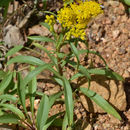More info for the term:
fernMissouri goldenrod is widespread throughout the Great Plains. It is not
listed as an indicator species in any plant community. It occurs with a
variety of associated species, depending on geographic location and site
conditions.
Associates of Missouri goldenrod in remnant upland tallgrass prairie in
west-central Missouri include eastern redcedar (Juniperus virginiana),
dewberry (Rubus flagellaris), chokecherry (Prunus virginiana), buck
brush (Symphoricarpos orbiculatus), leadplant (Amorpha canescens), and
wild snowball (Ceanothus americanus) [
21].
Associates of Missouri goldenrod in the sandhills tallgrass prairie of
southeastern North Dakota include sandhill bluestem (Andropogon hallii),
Penn sedge (Carex pennsylvanica), perennial ragweed (Ambrosia
psilostachya), white sage (Artemisia ludoviciana), narrow-leaved puccoon
(Lithospermum incisum), blazing star (Liatris punctata), and prairie
rose (Rosa arkansana) [
47].
Associates of Missouri goldenrod on benchlands in the Cypress Hills of
southeastern Alberta include shrubby cinquefoil (Potentilla fruticosa),
yarrow (Achillea lanulosa), starry chickweed (Cerastium arvense),
northern bedstraw (Galium boreale), prairiesmoke avens (Geum triflorum),
kinnikinnick (Arctostaphylos uva-ursi), American pasqueflower (Anemone
patens), prairie thermopsis (Thermopsis rhombifolia), and fleabane
(Erigeron spp.) [
11].
Associates of Missouri goldenrod in fluvial sand and gravel deposits of
the riparian zone in northwestern Montana include clover (Trifolium
spp.), dandelion (Taraxacum spp.), Virginia strawberry (Fragaria
virginiana), red-osier dogwood (Cornus sericea), kinnikinnick, and
russet buffaloberry (Shepherdia canadensis) [
27].
Associates of Missouri goldenrod in the northern Wisconsin pine barrens
include scattered jack pine (Pinus banksiana), bur oak (Quercus
macrocarpa), and northern pin oak (Quercus ellipsoidalis) as well as
grasses (Poaceae), bracken fern (Pteridium aquilinum), sweet fern
(Myrica asplenifolia), and lowbush blueberry (Vaccinium angustifolium) [
43].

